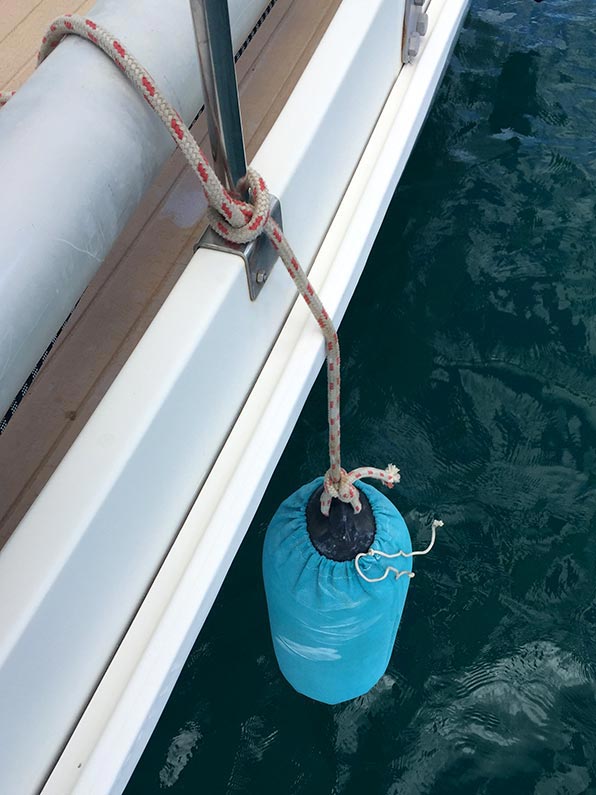How we now secure fenders
Here’s something every boater has to do on, at least, a semi-regular basis: rig lines and fenders for docking. There are a variety of ways to secure fenders to a boat, including tying them on with a clove hitch (more easily adjusted for height), a round turn and two half hitches (more secure), or by using one of several devises that take the place of tying knots. This is one such example that our friends on Two Fish use.

How do we do it? Before we approach the dock, we rig (plenty of) fenders using clove hitches so that they can be easily adjusted if the dock is higher or lower than we anticipated. After we’re safely tied up, if we’ll be staying there for some time and want them to be more secure, we may re-tie the fenders with a more secure hitch, or add a couple of half hitches to the existing knot.
But where do you attach the fenders to your boat? If you’re like most people, you probably attach them to the lifelines. We certainly did in the past, however now we secure them to the stanchion bases, or to deck cleats. Why the change? You may recall that, almost a year ago, we had the opportunity to go for a little sail with David Slater, son of Alan Slater, chief engineer and designer of PDQ Yachts. When we were getting ready to bring his catamaran into the marina, he made it clear that he was definitely opposed to the act of tying fenders to the lifelines. He said that he had seen many a leaking stanchion base caused by that practice. While I haven’t witnessed that myself, I could easily see how the increased leverage of having the fender tied near the top of a stanchion could affect that, assuming it got caught while bringing the boat alongside a dock. So, even though it is a bit less convenient, and more difficult to adjust, we now do as David suggested. I try to always keep an open mind and be receptive to new ideas, and new information!

Old way – tied to top rail.

New way – secured to base of stanchion.
NOTE: Don’t focus on the fact that Amels have a solid top rail instead of a lifeline. The same risks apply. We haven’t seen too many Amels that don’t have at least one bend in that tubing!



Good move!
I think so, but it’s also the type of thing that many people will say “well, I’ve tied them to the top rail for 20 years and I’ve never had any problems.” 🙂
It’s an easy change for us, and it’s better to be safe than sorry, IMO.
We have always tied at the bottom of the stantion…. it’s the engineer in me. However, you mentioned tying them to the deck cleat, don’t you need that for the lines? I think a boat manufacturer should get smart and MAKE a specific spot to hang fenders.
Our boat (1983 Amel) doesn’t even have a midship cleat! 🙁
We use the clove hitch method to tie to the lifeline. When we want the knot to be more secure we simply tie another clove hitch right over the top of the first one. That is not going to slip or come loose.
Tying low on the toerail or the stanchion base is an option on a larger boat with sufficient freeboard, but on many smaller boats that location may not work to hang the fender high enough to protect the boat. Also, limiting one’s self to the stanchion bases may not put the fender in the exact right place it needs to be to protect the boat’s hull to the maximum degree.
It is very true that tying the fender to the lifelines can damage them, and we found this out last fall when one of our sailing club’s boats came into a pumpout dock a little (ok a LOT) too hot and a fender got jammed behind one of timbers of the dock so that the clove hitch slid back along the lifeline until it hit the top of the stanchion, pulling hard enough to snap the stanchion in half. It broke at the hole for the second lifeline leaving us without a top lifeline for the rest of the trip. Luckily we were heading to the storage facility and it was the last trip of the season. A clove hitch should pull free in a perfect conditions but the line was old, a little rotted, and was wet. It didn’t give a milimeter but the stanchion sure did. It was an easy fix at the boatyard last winter to swap it out although we did find that the deck was spongy and we needed to fix that before putting the stanchion back on.
Stanchion bases often take a lot of punishment on most sailboats, even without tying fenders to the lifelines. I’m a big believer in using butyl tape to bed them down rather than “devil’s glue” which isn’t as flexible of a bedding compound and once it has been compromised will not self-reseal like butyl does. Making sure to bevel the through-deck bolt holes at the top will help a lot to allow the butyl tape to have more volume to fill up and avoids spider-cracking in the gel coat that often forms when these holes are not beveled and the stresses are concentrated on the sharp corner at the very top of the through-deck holes. Poor bedding is what caused the wet deck I mentioned above. If they had used butyl tape with beveled holes water probably would not have been able to get into the deck.
“devil’s glue”
I often refer to 5200 as The Devil!
🙂
Our club/school here in the SF Bay Area always taught us to use the stanchions. I never even thought about doing it any other way until our first charter in the BVI. We noticed the charter company used the life lines on all the boats, so we followed suit and later saw the obvious advantage that the fenders can easily be slide fore or aft to just the right spot. I never thought about the damage this could cause. I’m back the my old ways. Thanks Mike.
You’re welcome!
Yep, tied to the stanchion bases is the method I always use, for the very reasons you describe. Everybody has their opinion on where and how to tie ’em, but I seen this method be very successful in practice and believe in the “less leverage” theory too. Secured with a round turn and two half hitches, though. That hitch makes height adjustments easy and safe – the turn helps check the fender to the stanchion while you adjust its height.
I would expect nothing less from you. 🙂
Toe rails for me.
I don’t see how you could have fixed locations… but perhaps that is because some forks are thinking floating dock (only been at one a few times) vs. bulkheads with tides. In the bulkhead case, the fenders go where the pilings are (spacing varies) and there are generally fender boards in play.
I’ve seen the after math of a fender board that got stuck on a bolt head, with the line around a lifeline. In this case, the tide rose and the stanchions came clean off. Nice new trawler. Long faces.
Tide? What’s that? 😉